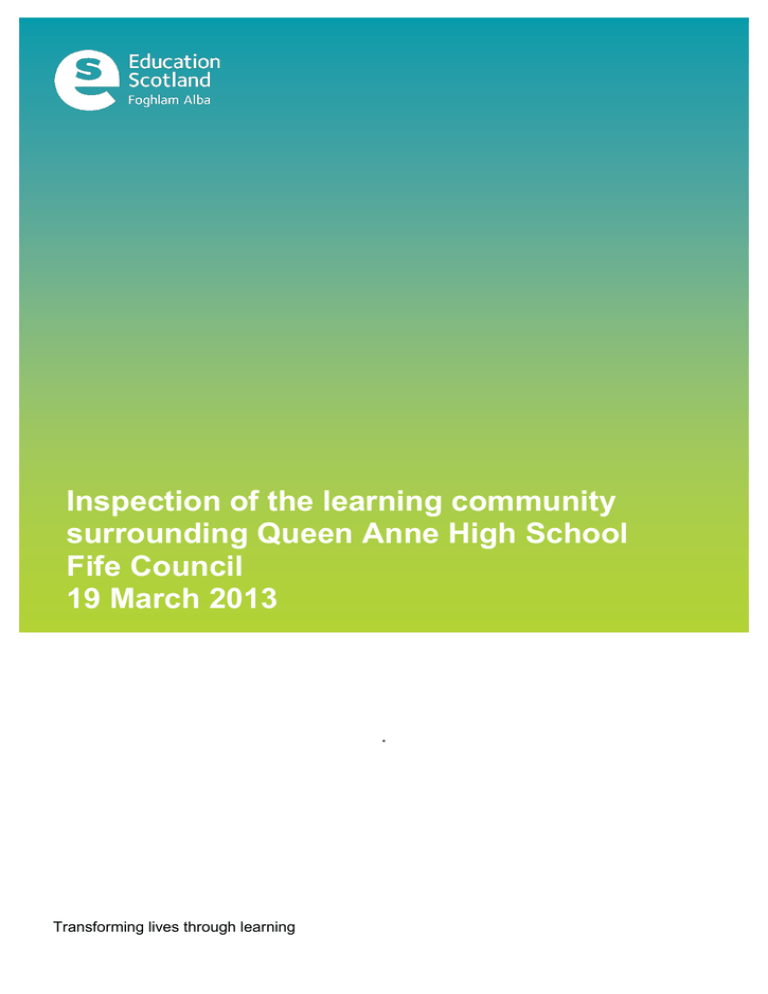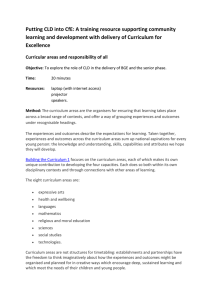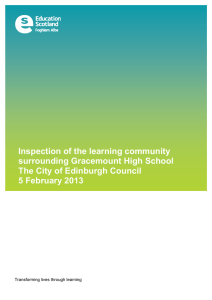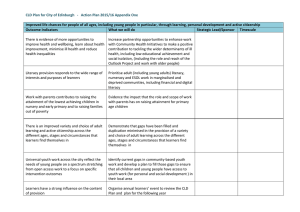Inspection of the learning community surrounding Queen Anne High School Fife Council
advertisement

Inspection of the learning community surrounding Queen Anne High School Fife Council 19 March 2013 . Transforming lives through learning 1. Context Community and learning development (CLD) partners within the area of Queen Anne High School were inspected by Education Scotland during January 2013. During the visit Education Scotland staff talked to children, young people and adults. We worked closely with local CLD managers, CLD providers, partners, paid staff and volunteers. We wanted to find out how well partners are improving the life chances of people living in the community through learning, building stronger more resilient communities and improving the quality of services and provision. We also looked at how well, paid staff and volunteers are developing their own practices and how well partners, including schools are working together. We looked at some particular aspects of recent work which were identified by partners including early years, parenting and family learning. The learning community surrounding Queen Anne High school has a population of over 25,000 and includes communities in North and Central Dunfermline as well as a number of small villages to the west of the town. It is culturally diverse with some areas of affluence as well as small pockets of deprivation. 2. How well are partners improving learning, increasing life chances, promoting and securing wellbeing? Across the learning community learners are achieving very well. They are becoming more confident and active in their local communities and improving life chances. CLD and their partners are effectively targeting priority groups, for example LGBT (lesbian, gay, bisexual and transgender) young people and young parents. Performance reporting is well embedded and reported to elected members and senior officers six monthly. Robust reporting systems demonstrate that CLD are meeting most targets set. Establishing benchmarking with other local authorities would help CLD partners develop further. Achievement for English for Speakers of other Languages (ESOL) and Adult Basic Education learners shows an increasing trend over the past three years. Learning programmes are of high quality. The number of young people gaining awards such as Youth Achievement and Dynamic Youth awards are improving. Increasing numbers of learners are now more active in their local communities as a result of their involvement. Many demonstrate that learning is improving life chances. Almost all young people involved in the 16+ group are achieving positive post-school destinations and now take more responsibility for their learning. Parents at the Beanstalk Nursery and Family Nights are reporting better outcomes in terms of health and wellbeing. Many are gaining qualifications and a few are going on to employment. Increasing numbers attend the Community Use Sports programme at Queen Anne High School. However, a greater focus on measuring health and wellbeing outcomes would help to better demonstrate impact. Young people are achieving very well through a good range of learning programmes. Members of the Youth Forum are gaining important communication skills through debating and writing articles for the local press. All members are now more confident and a few are applying their learning well in a school setting. Several young people involved in the Blairhall Recycling project and Youth Theatre groups 1 are linking their learning to the experiences and outcomes in Curriculum for Excellence. The Tower Centre music groups are well supported to develop their musical skills. They now regularly perform at weekend band nights and take responsibility for organising events. The Cairneyhill Scouts are effectively embedding the four capacities of Curriculum for Excellence in their programmes. Youth workers at the Tower Centre are using experiences and outcomes to measure young peoples’ progress. Young people are achieving well as a result. In most youth provision there are opportunities for young people to gain accreditation. Members of the LGBT group are gaining bronze and silver Youth Achievement Awards. Several of the 16+ group successfully achieved first aid certificates. Many young people are progressing to become volunteers. Very good partnership working between providers is leading to better outcomes for young people, for example employment and volunteering. Young people engaged in 16+ Activity Agreements are improving literacy skills. Individual young people are being well supported by CLD staff through individually designed learning programmes in partnership with Queen Anne High School. CLD and the staff at Queen Anne High School now need to establish a partnership planning approach to the senior phase of Curriculum for Excellence. Work with parents is well established across the learning community. There is a very strong focus on early intervention. Programmes at Beanstalk Nursery and the James Allen Centre are leading to very good outcomes for learners. Many parents are learning important practical skills and improving their literacy levels through a range of very effective programmes such as SewGood and Big Plus for parents. A few describe their experiences as life changing. Adults attending pedicure and manicure classes at Queen Anne High School Community Use are gaining qualifications and a few are starting up their own business. ESOL learners are progressing successfully to intermediate and advanced programmes. Reviewing the pace of progress could help them achieve further. The Client Action Team provide ESOL learners with good support to increase employability skills. Learners at the Tryst Centre are gaining accreditation including Scottish Qualifications Authority modules, European Computer Driving Licence and City and Guilds. Adult Basic Education provision at East Port Centre is learner-centred and flexible. It meets the needs of learners very well. Individual learning plans set clear goals that are regularly reviewed. A few learners are moving on to employment and are progressing in their workplace. Others are becoming volunteers. Hard to reach learners are well targeted by CLD and their partners at Valleyfield Centre. Free transport and childcare is helping to break down barriers to learning. Learners would welcome further information about how their feedback influences provision. CLD providers support a range of effective community groups that are achieving well. Almost all community groups are self reliant, independent and successfully fundraise to support their activities. Young people in the Blairhall MUGA (Multi Use Games Area) are successfully raising awareness of issues in their community, gaining the respect of local adults and elected members. The Blairhall Recycling project is helping young people to better understand environmental issues. Local churches work well in partnership to address identified community need. They support experienced and skilled volunteers well. The Street Pastors project provides important support and assistance to vulnerable people. The Dunfermline Food Bank that provides emergency food provision to vulnerable people links well into 2 community planning through the Community Safety Partnership. Almost all community groups have effective systems in place for planning and evaluation. Through the Coalfields Regeneration Trust residents of the villages of Oakley and Comrie are developing services based on identified needs. Communities are becoming more resilient and are viewed by CLD providers as equal partners in the planning consultation and engagement process. Community groups are inclusive overall. They appropriately refer to other agencies and groups and work well together to avoid duplication. CLD partners should now consider reviewing systems for gathering community information, sharing and networking. The devolving of budgets to local level helps community groups to design and deliver services based on community need. 3. How well are partners working together and improving the quality of services and provision? Across the learning community CLD partners work effectively together to improve the quality of services. Strong partnership working is very well established and is leading to improved outcomes for learners. GIR (Getting it Right for Every Child) groups support a varied programme that is very well linked to Council strategic priorities. The Family and Community Support Team support vulnerable families very well, many of who are referred by other agencies. Well-attended planning sessions are helping agencies to understand the role of a ‘lead professional’. The Quality Framework that underpins the work of CLD staff is used very effectively to evaluate learning programmes. The Dunfermline Area Adult Learning Local planning group links very well with the Fife Childcare strategy and other providers. Actions are incorporated in the performance scorecard that reports on progress. Local intelligence is used well to address priorities that brings about improvements to life chances and promote health and wellbeing for learners. Partnership self-evaluation is leading to improvements for learners across the learning community. The South West Youth Strategy group use a robust multi-agency approach to review their work. CLD staff in Dunfermline engage colleagues from other CLD teams to validate their internal self-evaluation. As a result, outcomes for learners are improving. Partners use a wide range of methods for gathering information from participants and other stakeholders. Annual performance reporting is very well established. Reporting at a strategic level is currently being amended in light of the new Strategic Guidance for Community Planning Partnerships. This is now being reflected at local learning community level. Success is celebrated well and regularly through YOSCARs (youth awards), Citizen of the Year and Fife adult learning awards. CLD partners have very good arrangements for workforce development. Prudent budgeting ensures a strong commitment to training youth workers in particular. CLD staff regularly reflect on their work and plan for improvement. Continuing Professional Development (CPD) is actively promoted and encouraged by managers. CLD workers and part-time staff receive regular and effective support and supervision as well as annual reviews of performance. Planning systems promoted by CLD are used across services to ensure consistency. Staff attendance in CLD is robustly monitored. There have been few absences in the past five years 3 and very low staff turnover. CLD staff are subject to a five year rotation of their posts to ensure career long professional learning. Youth workers and adult tutors are well trained and supported. All complete mandatory training and are encouraged to enhance their skills. CLD and NHS Fife collaborate very well to provide additional CPD opportunities. This inspection of learning and development in the learning community surrounding Queen Anne High School found the following key strengths. Highly developed partnerships and positive collaborative working. Continuous improvement which is embedded in practice. Innovative professional learning leading to well-trained and highly motivated staff. Joint reviewing and planning with partners. Well-targeted provision for young people, adults and community groups which is improving life chances. We discussed with partners how they might continue to improve their work. This is what we agreed with them. Build on current relationships with Queen Anne High School to plan better for the Senior Phase of Curriculum for Excellence. Ensure that learners are aware of how feedback is used to influence future programmes. Investigate opportunities for benchmarking with other local authorities. 4. What happens at the end of the inspection? The inspection team was able to rely on the high quality self-evaluation provided by the learning community. Partners have a good understanding of their strengths and areas for improvement and communities are achieving very well. As a result we have ended the inspection process at this stage. Sheila Brown HM Inspector 19 March 2013 4 Additional inspection evidence, such as details of the quality indicator evaluations, for this learning community can be found on the Education Scotland website at http://www.educationscotland.gov.uk/inspectionandreview/reports/othersectors/com munitylearninganddevelopment/QueenAnneHighSchoollc.asp Please contact us if you want to know how to get the report in a different format, for example, in a translation. You can contact us at enquiries@educationscotland.gsi.gov.uk or write to us at Education Scotland, Denholm House, Almondvale Business Park, Almondvale Way, Livingston EH54 6GA. If you want to give us feedback or make a complaint about our work, please contact 01506 600200, or write to us at the above address or email: feedback@educationscotland.gsi.gov.uk. Text phone users can contact us on 01506 600 236. This is a service for deaf users. Please do not use this number for voice calls as the line will not connect you to a member of staff. You can find our complaints procedure on our website or alternatively you can contact www.educationscotland.gov.uk to our Complaints Manager, at the address above or by telephoning 01506 600259. Crown Copyright 2013 Education Scotland 5



